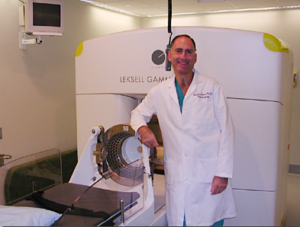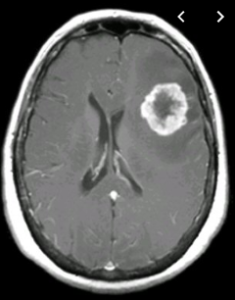By: Stephen Saris, M.D.
What is a Gamma Knife?
The Gamma Knife is a medical device that focuses a very large amount of radiation on a lesion in the brain to shrink or destroy it.
How does the Gamma Knife work?
The best way to understand the Gamma Knife is to image an entertainer on a stage in Las Vegas. When that individual first comes on stage, the room is dark. When the spot lights are turned on, all intersect on the entertainer. She or he is brightly illuminated, and all around is dark and can barely be seen. The Gamma Knife works on a similar principle, except instead of spotlights, there are about 200 pencil thin “spotlights” of radiation. These are about the size of a pea in diameter, and all intersect precisely on the area of the brain that I want to destroy. The normal brain structures around that do not receive any significant amount of this radiation.
What is Gamma Knife used for?
The technology was first developed in Sweden many decades ago for the treatment of facial pain (tic douloureux). In the years since, its use has been expanded for a multitude of conditions including arteriovenous malformation, benign tumors of the brain such as pituitary tumors, meningiomas, acoustic neuromas (now known as vestibular schwannomas), and others. It also is commonly used, and is very effective, when a cancer has spread to the brain (a metastasis, shown in image).
Potential sources for litigation:
I have been performing Gamma Knife radiosurgery since 1993. I have treated hundreds of patients with gamma knife, and during that time I have also had the opportunity to review medicolegal cases that pertains to its use. Some issues which may arise and require a gamma knife expert witness include:
1. Lack of discussion of the gamma knife as a treatment option for benign conditions such as vestibular schwannomas or pituitary tumors. While open surgery is within the standard of care, gamma knife may be attractive to patients as it offers different risks, outcomes, and recovery times.
2. Delay in diagnosis for small tumors. When benign tumors are caught at an early stage, one common treatment option is Gamma Knife radiosurgery. If the neoplasm becomes larger, radiosurgery is no longer an option and a cranial procedure and resection may be needed. This may have been avoided with earlier diagnosis and minimally invasive radiosurgical treatment.
Conclusion
An expert witness knowledgeable about gamma knife procedures may be a valuable resource during litigation where lack of use or misuse of radiosurgery is alleged.
Stephen C. Saris, MD is a board-certified neurosurgeon who practices in both Massachusetts and Rhode Island. His practice involves both brain and spine. He has practiced gamma knife radiosurgery since 1993. He has lectured on this subject at Harvard Medical School (Brigham and Women’s Hospital Grand Rounds) and Rhode Island Hospital. Dr. Saris trained at Harvard and Duke, and is currently on the faculty of both Harvard and Brown. Dr. Saris is a highly experienced expert witness, who has given more than 500 depositions and appeared in court more than 50 times.
Office: 401.453.3545 * Fax: 401.453.3533 * Cell: 401.378.2921
* Website: www.neurosurgery-associates.co








